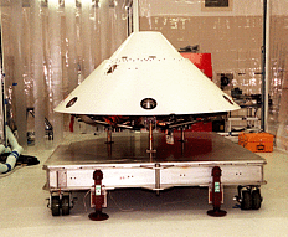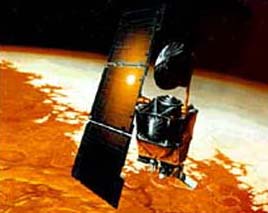Artist's depiction of the Mars Climate Orbiter.
Click on image for full size
Courtesy of NASA
NASA Loses Climate Orbiter (Updated!)
News story originally written on October 4, 1999
The loss of the Mars Climate Orbiter has turned into a nightmare for NASA. The agency has released information blaming a mistake in measurements as the cause of the mishap.
The problem occurred when a team at Lockheed Martin submitted acceleration data in pounds of force. Unfortunately, scientists at the Jet Propulsion Laboratory assumed the numbers were in metric newtons. In other words, there was a mistake made in the units.
``It was embedded in the system from the beginning,'' said Tom
Gavin, deputy director of JPL's space and Earth science program. ``We're
still looking at why it was not detected.''
``People sometimes make errors,'' said Edward Weiler, the National
Aeronautics and Space Administration's associate administrator for space
science. ``The problem here was not the error, it was the failure of ...
the checks and balances in our processes to detect the error. That's why we
lost the spacecraft.''
The spacecraft was lost when it flew too close to the Red Planet. It was supposed to study Mars' climate for 687 days. Scientists believe the orbiter burned up in Mars' atmosphere.
You might also be interested in:

Cross your fingers! The Mars Polar Lander is scheduled to meet the Red Planet on December 3, 1999. Unlike the Mars Climate Orbiter, which would have orbited Mars, the Polar Lander will actually land on
...more
It was another exciting and frustrating year for the space science program. It seemed that every step forward led to one backwards. Either way, NASA led the way to a great century of discovery. Unfortunately,
...more
The Space Shuttle Discovery lifted off from Kennedy Space Center at 2:19 p.m. EST, October 29th. The sky was clear and the weather was great as Discovery took 8 1/2 minutes to reach orbit for the Unitied
...more
A moon was discovered orbiting the asteroid, Eugenia. This is only the second time in history that a satellite has been seen circling an asteroid. A special mirror allowed scientists to find the moon
...more
Will Russia ever put the service module for the International Space Station in space? NASA officials are demanding an answer from the Russian government. The necessary service module is currently waiting
...more
During a period of about two days in early May, 1998, the ACE spacecraft was immersed in plasma associated with a coronal mass ejection (CME). The SWICS instrument on ACE, which determines unambiguously
...more
J.S. Maini of the Canadian Forest Service has referred to forests as the "heart and lungs of the world." Forests reduce soil erosion, maintain water quality, contribute to atmospheric humidity and cloud
...more















